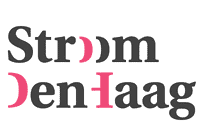Alfred Eikelenboom, 1994, 'Zonder titel', staal foto: Renate Boere, Cas Marks, Laurens van der Pool
Alfred Eikelenboom, (no title), 1994
The sculptures of Alfred Eikelenboom (1936) almost never have pedestals. And when they do, they are usually not a subordinate element. This is also the case with his pedestal sculpture in the center of The Hague. The pedestal is an essential part of the overall piece. Eikelenboom has achieved a unity through form and color repetition. The oval shape of the pedestal is echoed in the columns, and the gray of the pedestal seamlessly transitions into the gray of the sculpture. In fact, if the pedestal had not been gray, Eikelenboom would have painted it gray himself. Almost all of Eikelenboom’s sculptures are gray. He is concerned purely with form, not color.
Since the late 1960s, Eikelenboom has dedicated himself to exploring form. He refers to the results as ‘utopian models’: sculptures that represent his ideas about architecture. His pedestal sculpture is such a ‘utopian model’. The starting point for the steel sculpture is the mushroom. With the two oval columns and the dome-shaped capital at the top, Eikelenboom has given the plant an architectural appearance.
Although architecture is of particular interest to him, he draws his visual vocabulary from nature, such as the mushroom, and from forms that are not typically found in architecture. While cubes and squares dominate architecture, Eikelenboom bases his work on conic sections, circles, and rounded rectangles. With his ‘utopian models,’ Eikelenboom aims to present architects and urban planners with a new visual language. The models are not models in the traditional sense, but rather futuristic visions. They are not lofty dreams, escapes, or expressions of dissatisfaction, but a form of constructive criticism. With a variety of forms, he offers architects an alternative to the monotonous construction with blocks. And he continues to do so.

